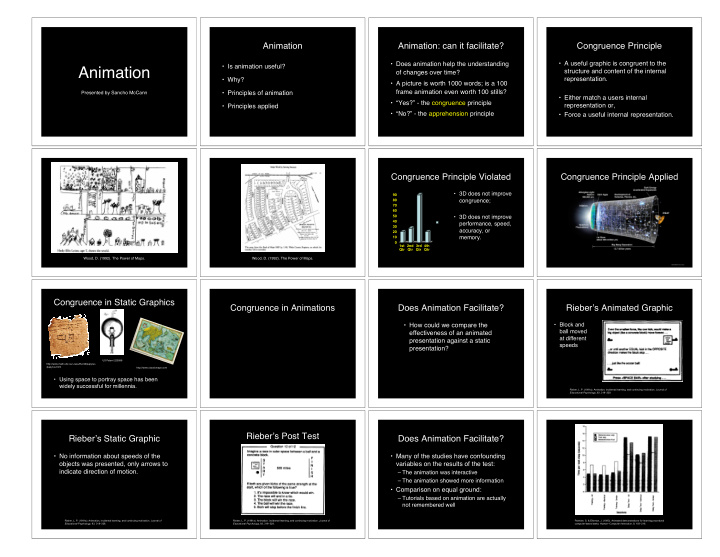



Animation Animation: can it facilitate? Congruence Principle • A useful graphic is congruent to the • Does animation help the understanding • Is animation useful? Animation structure and content of the internal of changes over time? representation. • Why? • A picture is worth 1000 words; is a 100 • Principles of animation frame animation even worth 100 stills? Presented by Sancho McCann • Either match a users internal • “Yes?” - the congruence principle representation or, • Principles applied • “No?” - the apprehension principle • Force a useful internal representation. Congruence Principle Violated Congruence Principle Applied • 3D does not improve 90 congruence; 80 70 60 50 • 3D does not improve 40 East performance, speed, 30 accuracy, or 20 memory. 10 0 1st 2nd 3rd 4th Qtr Qtr Qtr Qtr Wood, D. (1992). The Power of Maps. Wood, D. (1992). The Power of Maps. Congruence in Static Graphics Congruence in Animations Does Animation Facilitate? Rieber � s Animated Graphic • How could we compare the • Block and ball moved effectiveness of an animated at different presentation against a static speeds presentation? US Patent 223898 http://www.math.ubc.ca/~cass/Euclid/papyrus /papyrus.html http://www.classicmaps.com • Using space to portray space has been widely successful for millennia. Rieber, L. P. (1991a). Animation, incidental learning, and continuing motivation. Journal of Educational Psychology , 83, 318–328. Rieber � s Post Test Rieber � s Static Graphic Does Animation Facilitate? • No information about speeds of the • Many of the studies have confounding objects was presented, only arrows to variables on the results of the test: indicate direction of motion. – The animation was interactive – The animation showed more information • Comparison on equal ground: – Tutorials based on animation are actually not remembered well Rieber, L. P. (1991a). Animation, incidental learning, and continuing motivation. Journal of Rieber, L. P. (1991a). Animation, incidental learning, and continuing motivation. Journal of Palmiter, S. & Elkerton, J. (1993). Animated demonstrations for learning procedural Educational Psychology , 83, 318–328. Educational Psychology , 83, 318–328. computer-based tasks. Human–Computer Interaction , 8, 193–216.
Why Not? Why Not? Advice • The apprehension principle states that • Minds are not easily forced to hold a • Useful when timing is important the external representation must be continuous representation. • Realism is not important, your readily and accurately perceived and The Music Animation • Animations are comprehended information is Machine comprehended. discretely. – Slow down animations at critical phases • Different viewers will take away different – Annotate, highlight, direct attention • Animation violates this principle! elements from an animation. – Eliminate unnecessary information • Animation is fleeting. • Allow interaction Interactive Animation Interactive Animation Interactive Animation Animation useful for • Richard Lowe. User-Controllable • Animation is not fleeting • Given: timing? Animated Diagrams: The Solution for – 28 frame user-controllable weather map • Animation is not overwhelming Learning Dynamic Content? representing a 7 day period – Another “Original” weather map • View animation at any speed • Task: • Extract fine and coarse grained – Use patterns learned in the animation to predict the weather map 24 hours after the information “Original” Interactive Animation Animated Interaction Interactive Animation Animated Interaction • Animation only used for an overview • Animation does aid understanding of interactive and dynamic changes to an interface. • Novice users did not use animation to learn temporal relations between features; they didn � t know to look! • The animation degraded to a flip-book of images Richard Lowe. User-controlled animated diagrams: the solution for learning dynamic content?. In Lecture Notes in Computer Science - Diagrammatic Representation and Inference. Springer-Verlag, 2004. Principles of Animation Principles of Animation Squash and Stretch Timing • John Lasseter. Principles of Traditional • From classes promoted by Walt Disney Animation Applied to 3D computer in the 1930s, The 11 Principles arose Animation. 1987.
Anticipation Staging Staging Slow-In Slow-Out Arcs Exaggeration Three Other Principles Appeal • Follow-through and Overlapping Action • Straight Ahead or Pose-to-Pose • Secondary Action Principles Applied An Application An Application • David Carr and Matja_ Kljun. The Effect • How is staging applied? of Animated Transitions on User Navigation in 3d Tree-Maps. • How is anticipation applied? Proceedings of the 9th Intl. Conference • What other principles are applied? on Information Visualization (IV 2005) . • What principles could have been applied? Discussion Summary Papers • Barbara Tversky, Julie Bauer Morrison and • Animation did allow for different types of • Animation is deceivingly attractive Mireille Betrancourt. Animation: can it navigation - short-cuts facilitate?. In International Journal of Human- Computer Studies, 57 . Elsevier Science Ltd, • Interactive animation might help 2004. • The short-cuts were not effective - • Richard Lowe. User-controlled animated users got lost. • Animated interaction does help diagrams: the solution for learning dynamic content?. In Lecture Notes in Computer Science - Diagrammatic Representation and Inference. Springer-Verlag, 2004
Papers • John Lasseter. Principles of traditional animation applied to 3D computer animation. In ACM Journal of Computer Graphics, 21 - 4, July 1987. • Bladh, T., Carr, D. A., and Kljun, M. 2005. The Effect of Animated Transitions on User Navigation in 3D Tree-Maps. In Proceedings of the Ninth international Conference on information Visualisation (Iv'05) - Volume 00 (July 06 - 08, 2005). IV. IEEE Computer Society, Washington, DC, 297-305.
Recommend
More recommend